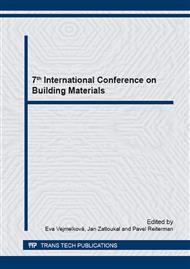[1]
P. Reiterman, O. Holčapek, K. Polozhiy, P. Konvalinka, Fracture Properties of Cement Pastes Modified by Fine Ground Ceramic Powder, Advanced Materials Research 1054 (2014) 182 – 187.
DOI: 10.4028/www.scientific.net/amr.1054.182
Google Scholar
[2]
M. Jogl, P. Reiterman, O. Holčapek, J. Koťátková, Proposal of Fire Resistant Composites with Application of Lightweight Aggregate Liaver, Advanced Materials Research 1054 (2014) 43 – 47.
DOI: 10.4028/www.scientific.net/amr.1054.43
Google Scholar
[3]
M. Čáchová, D. Koňáková, E. Vejmelková, K. Polozhiy, R. Černý, Pore Distribution and Water Vapor Diffusion Parameters of Lime Plasters with Water Brick Powder, Advanced Materials Research 1054 (2014) 205 – 207.
DOI: 10.4028/www.scientific.net/amr.1054.205
Google Scholar
[4]
M. Čáchová, D. Koňáková, E. Vejmelková, P. Reiterman, M. Keppert, R. Černý, Properties of Lime Plasters with Different Ceramic Powder Dosage, Applied Mechanics and Materials 621 (2014) 19-23.
DOI: 10.4028/www.scientific.net/amm.621.19
Google Scholar
[5]
ČSN EN 197-1: Cement - Part 1: Composition, specifications and conformity criteria for common cements, (2012).
Google Scholar
[6]
ČSN EN 1015-3 – Methods of test for mortar for masonry - Part 3: Determination of consistence of fresh mortar (by flow table), (2000).
DOI: 10.3403/01541440
Google Scholar
[7]
ČSN EN 1015-10: Methods of test for mortar for masonry - Part 10: Determination of dry bulk density of hardened mortar, (2000).
DOI: 10.3403/01905430
Google Scholar
[8]
Kumaran, M. K.: Moisture Diffusivity of Building Materials from Water Absorption Measurements, IEA Annex 24 Report T3-CA-94/01, Ottawa (1994).
Google Scholar
[9]
ČSN EN 1015-18: Methods of test for mortar for masonry - Part 18: Determination of water absorption coefficient due to capillarity action of hardened mortar, (2003).
DOI: 10.3403/02720093u
Google Scholar
[10]
D. Koňáková, V. Hovorková, E. Vejmelková, M. Keppert, R. Černý, Influence of Metashale as Cement Replacement on the Hydric Transport Properties of Concrete, Advanced Materials Research 1054 (2014) 188 – 193.
DOI: 10.4028/www.scientific.net/amr.1054.188
Google Scholar
[11]
ČSN 72 7031: Determination of water vapour diffusion coefficient of building materials by method without temperature gradient, (2001).
Google Scholar


